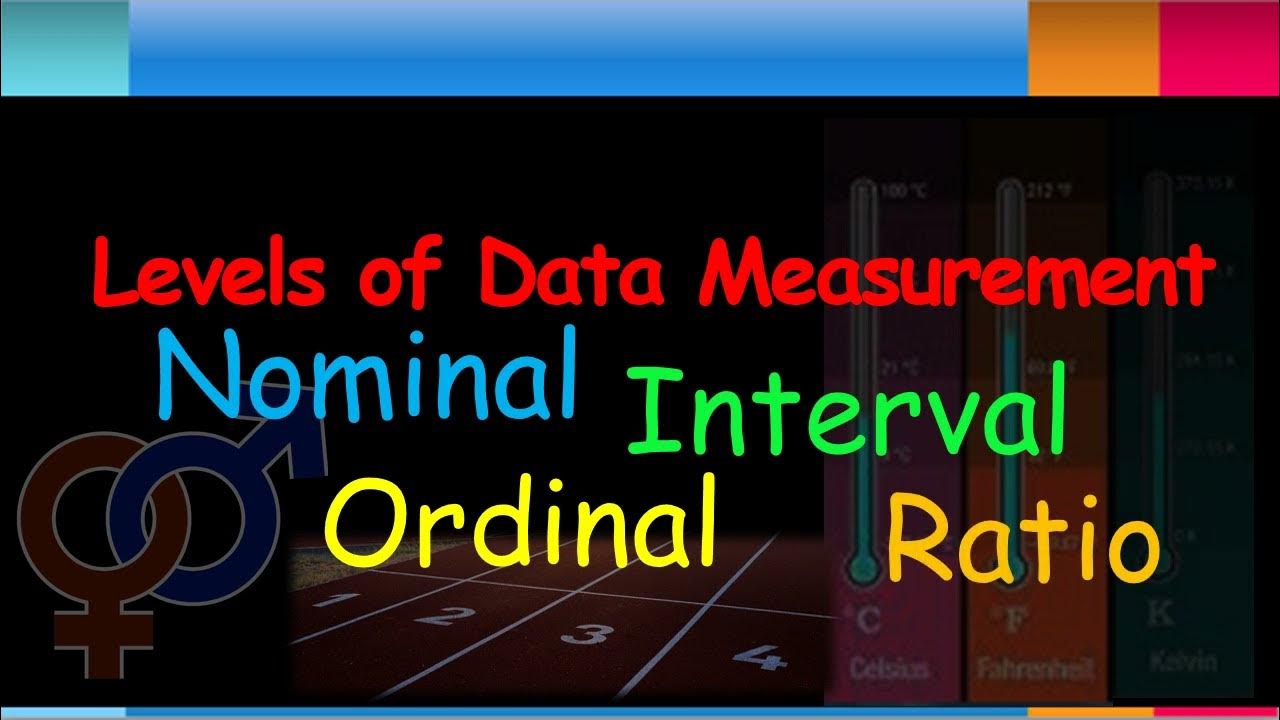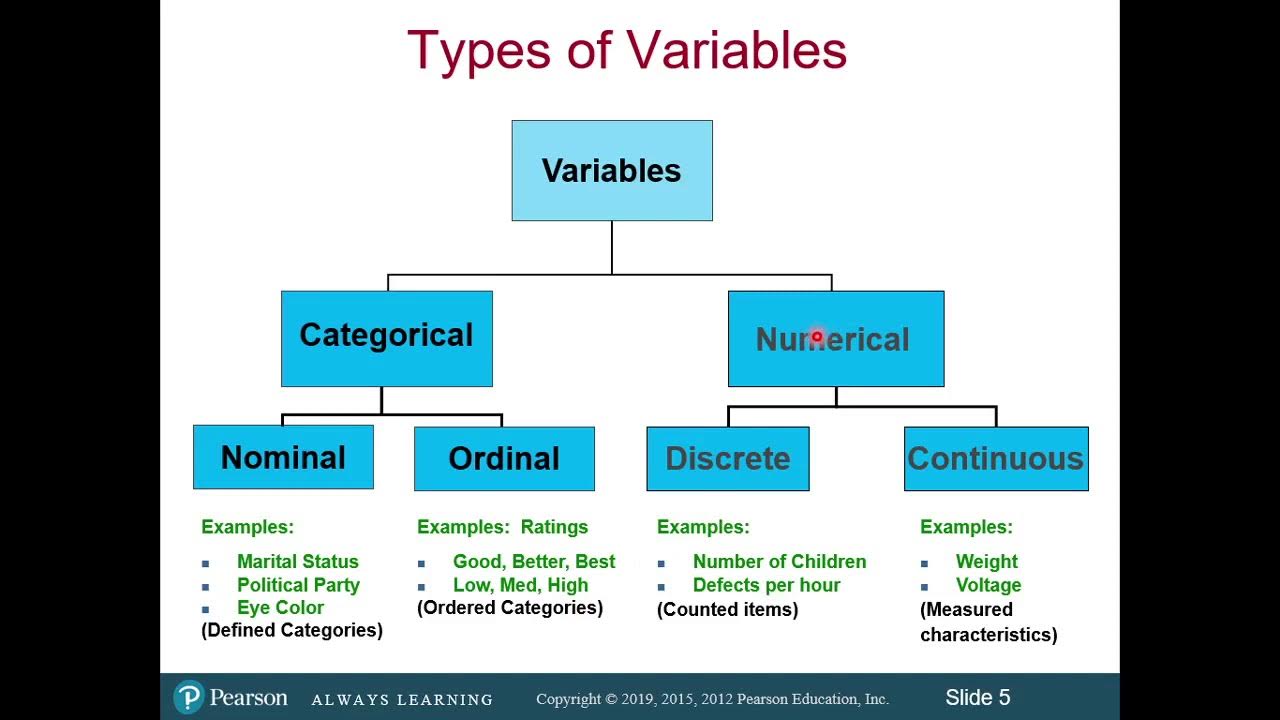Introduction to Levels of Measurement: Nominal, Ordinal, Interval, Ratio
TLDRThis video script delves into the concept of levels of measurement, categorizing them into nominal, ordinal, interval, and ratio. Nominal represents pure categories without order, such as shoe brands. Ordinal involves ordered categories, like movie star ratings. Interval levels involve numerical data without a true zero, exemplified by temperature. Lastly, ratio levels include numerical data with a true zero, such as the cost of items. The script uses examples to clarify each level, emphasizing the importance of understanding these distinctions for data analysis.
Takeaways
- 📊 Levels of measurement are used to classify and further break down data into categories.
- 🏷️ The nominal level is the first and deals with pure categories without any natural ordering, like brands or flavors.
- 🔢 The ordinal level consists of categories that can be ordered, but cannot be subjected to mathematical operations, such as performance ratings.
- 🔍 The interval level introduces numerical data, but lacks a true zero point, making it tricky to interpret, with examples like temperature and time.
- 📈 At the ratio level, numerical data includes a true zero, allowing for comparison and calculation, such as costs or distances.
- 👟 Brand of shoe is an example of nominal level data, as it cannot be ordered.
- 🌡️ Temperature is a clear example of interval level data, as it can have negative values and does not start from zero.
- 🍔 Cost of a cheeseburger represents ratio level data, as it can theoretically start from zero and allows for mathematical operations.
- ⭐ Movie ratings are ordinal level because they have a natural order (1 star < 2 stars < 3 stars) but cannot be added or subtracted.
- 🕰️ Time of arrival or departure is interval level, as it does not start from zero and can go into negative values.
- ✅ Understanding the differences between these levels is crucial for proper data analysis and interpretation.
Q & A
What are the four levels of measurement discussed in the video?
-The four levels of measurement discussed are nominal, ordinal, interval, and ratio.
What is the defining characteristic of the nominal level of measurement?
-The nominal level is characterized by pure categories without any natural ordering.
Provide an example of a nominal level measurement.
-Brands of shoes, such as Nike, Adidas, Reebok, and Puma, are an example of a nominal level measurement.
How is the ordinal level of measurement different from the nominal level?
-The ordinal level still involves categories, but these can be ordered or ranked, unlike the nominal level.
What is an example of an ordinal level measurement?
-Work performance ratings like poor, okay, and good represent an ordinal level measurement.
What is the key feature of the interval level of measurement?
-The interval level involves numerical data where zero is not the starting point, and there are equal intervals between data points.
Why is temperature considered an interval level measurement?
-Temperature is an interval level measurement because zero does not represent the coldest possible temperature; it can be negative, indicating a different starting point.
What is the ratio level of measurement and what distinguishes it from the interval level?
-The ratio level involves numerical data with a true zero point, which is the smallest value the data set can have. This is different from the interval level, which does not have a true zero starting point.
Provide an example of a ratio level measurement.
-The cost of a house is an example of a ratio level measurement, as it can theoretically be zero, which is the smallest possible value for cost.
How can one differentiate between interval and ratio levels when both involve numerical data?
-The key difference is the presence of a true zero. Interval levels do not start from zero, whereas ratio levels do have a true zero, indicating the smallest possible value.
What is the main point to remember when identifying the level of measurement for time-related data?
-When dealing with time-related data, it is crucial to note whether it refers to time of arrival or departure, as these are interval measurements. Other time measurements, like the time it takes to do something, are ratio if they can start from zero.
Outlines
📊 Introduction to Levels of Measurement
This paragraph introduces the concept of levels of measurement, which is a method to categorize and classify data. It explains four distinct levels: nominal, ordinal, interval, and ratio. The nominal level involves pure categories without any natural ordering, such as brand names. The ordinal level still deals with categories but allows for a natural order, like performance ratings. The interval level introduces numerical data where zero is not the starting point, exemplified by temperature and time. Lastly, the ratio level includes numerical data with a true zero point, such as costs, indicating the smallest value possible.
🌟 Understanding and Identifying Levels of Measurement
The paragraph delves into applying the concept of levels of measurement to various examples. It clarifies how to identify whether a data set is nominal, ordinal, interval, or ratio. The discussion includes examples like brand names (nominal), movie ratings (ordinal), temperature (interval), and costs (ratio). It also addresses misconceptions, such as mistaking any time measurement for interval when it is specifically time of arrival or departure that qualifies as interval. This section reinforces the understanding of levels of measurement and provides a framework for classifying different types of data.
Mindmap
Keywords
💡Levels of Measurement
💡Nominal Level
💡Ordinal Level
💡Interval Level
💡Ratio Level
💡Data Classification
💡True Zero
💡Time of Arrival/Departure
💡Mathematical Operations
💡Data Analysis
Highlights
Levels of measurement are a way to further breakdown and classify data.
The first level of measurement is called the nominal level, dealing with pure categories.
Nominal level examples include brand of shoe and car, with no natural ordering for the categories.
The second level of measurement is ordinal, which involves categories that can be ordered.
Ordinal examples include performance ratings like bad, okay, and good.
The interval level of measurement involves numbers, but zero is not the starting point.
Temperature and time are key examples of interval level measurements.
The ratio level of measurement also involves numbers, but with a true zero as the starting point.
Cost of a house is an example of a ratio level measurement.
Movie ratings are ordinal level measurements, with a natural order from 1 to 3 stars.
The number of questions on an exam is a ratio level measurement, as it can start from zero.
The time of arrival or departure is always interval level, as zero is not the starting point.
The time it takes to eat a pizza is a ratio level measurement, as it can be zero.
Understanding levels of measurement is crucial for statistical analysis and data interpretation.
Each level of measurement has specific characteristics that define how the data can be used.
The distinction between ordinal and ratio levels hinges on the presence of a true zero.
Proper classification of data is essential for accurate statistical procedures and results.
The video provides clear examples to illustrate the differences between each level of measurement.
The concepts of levels of measurement are fundamental in the field of research and data analysis.
Transcripts
Browse More Related Video

Data Types - Levels of Data Measurements - Nominal Ordinal Interval Ratio | Statistics | Research

Nominal, Ordinal, Interval & Ratio Data: Simple Explanation With Examples

Classification of Variables and Types of Measurement Scales

Scales of Measurement - Nominal, Ordinal, Interval, Ratio (Part 2) - Introductory Statistics

Scales of Measurement in Statistics - Nominal, Ordinal, Interval, Ratio | Level of Measurement

Scales of Measurement - Nominal, Ordinal, Interval, & Ratio Scale Data
5.0 / 5 (0 votes)
Thanks for rating: